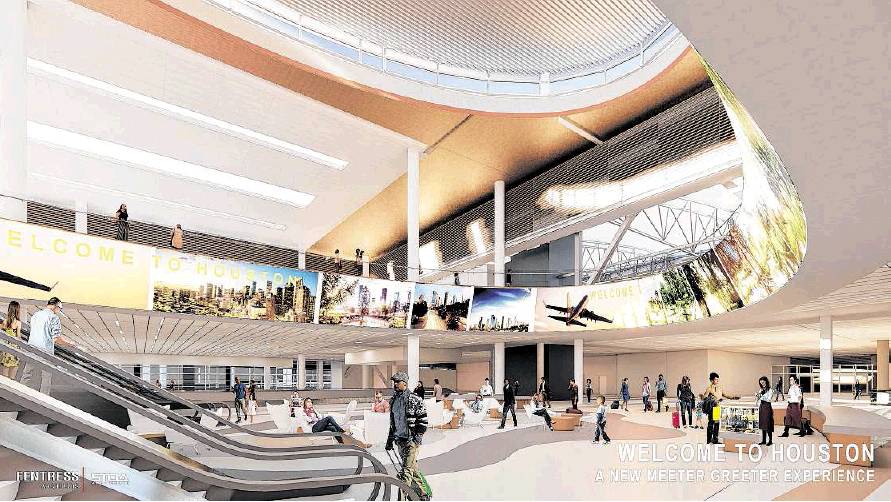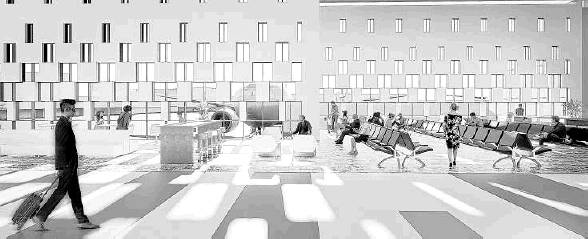Big expansion is planned for IAH’s international terminal
$1.23B project includes gates for wide-body jets
By Andrea Leinfelder STAFF WRITER
Bush Intercontinental Airport will begin redeveloping its international terminal on Friday, a project years in the making that will ultimately increase Houston’s capacity for wide-body jets capable of reaching new international destinations.
The $1.23 billion project essentially combines Terminal D and Terminal E into one terminal with a central area to house the ticket counters, security checkpoint and baggage claim. Today, international travelers departing on foreign airlines go to Terminal D, and international travelers on Chicago-based United Airlines go to Terminal E.
The project also includes six new gates for wide-body aircraft, such as the Airbus A350 and the Boeing 777 or 787 Dreamliner, bringing the total to 13 wide-body gates on the north side of the new international terminal and six wide-body gates on the south of the terminal, plus additional room for narrower, single-aisle aircraft.
The expansion will allow the airport to continue adding international airlines, which is viewed as essential to a region that is home to dozens of companies that do business around the world, as well as international companies, particularly in the energy industry, that have headquartered U.S. subsidiaries here.
“There is no international city in the world today that can grow without a major international airport,” said Houston Airport System Director Mario Diaz. “If you can’t connect to other cities around the world, you can’t do business with them.”
Friday’s groundbreaking comes nearly four years after the Houston Airport System first sought City Council approval to redevelop Terminal D, also called the Mickey Leland International Terminal. The project was initially delayed in late 2015 over concerns about potential procurement rule violations. Then the Houston Airport System, upon giving the initial plan additional scrutiny, realized the scope of the project needed to be broadened to consider how roadways, baggage systems and other aspects of the airport experience would be affected by an influx of international travelers . This broadened plan was first presented to the public in September 2018.
Ultimately, the updated project is estimated to save about $500 million from the original 2015 proposal, Diaz said.
“I have no regrets whatsoever about slowing this down and taking a different path,” Diaz said. “We saved $500 million and get a superior product. Something that the citizens of this city can really be proud of when it’s finished.”
Diaz outlined the plans and provided updated renderings to City Council’s Economic Development Committee on Thursday. The project’s $1.23 billion will come through federal grants for airfield work, revenues retained by the Houston Airport System from concessions, parking, rent paid by airlines, passenger facility charges, and roughly $700 million in bonds.
The bonds will be repaid through fees assessed on airlines and other tenants for use of the new terminal. None of this will include taxpayer funds, Diaz said.
Pete Garcia, a Houston airline consultant, said the new plan offers a more comprehensive solution than the original plan to the growing international traffic at the airport and the challenges it presents.
“They were just trying to piecemeal a fix to it, and it needed more than that,” Garcia said. “I’m glad that they looked at it a lot longer and more in depth to try and deliver the best service that they could.”
Bush Intercontinental Airport has added 13 international airlines since 2010. But after Dec. 15, when Ethiopian Airlines begins flying to Houston from Lomé, Togo, in West Africa, the airport likely won’t be able to accommodate additional foreign airlines during peak times between 1 p.m. to 8 p.m., Diaz said.
Diaz said the project’s addition of six wide-body gates would enable additional nonstop flights to the other side of the world. These aircraft have wider wings that allow for more lift, which increases fuel efficiency and allows it to reach destinations such as Sydney or Dubai.
The project will begin by demolishing Terminal C North, which will be replaced by a pier for the new six wide-body gates. United previously vacated the old Terminal C North and opened its new Terminal C North in 2017 to prepare for the international terminal project.
The new international terminal will get both aesthetic and technological upgrades, such as facial recognition that could replace the need for boarding passes. It also will include a new facility for the Transportation Security Administration to screen bags.
The TSA baggage facility and new pier are slated to open in the second and fourth quarters of 2022, respectively.
Terminal D renovations would be completed in the fourth quarter of 2023. The central area for ticketing and baggage claim, which first requires the demolition of the Terminal D/E parking garage and the addition of two floors to the Terminal C parking garage, is expected to open in the fourth quarter of 2024.
All of this would be accompanied by an improved baggage system capable of handling the larger number of people on planes, new utilities including water and electrical lines, and newly paved roads, including 12 lanes for dropping off passengers and nine for picking up passengers.
The project has received scrutiny over the years. Starting in late 2015, City Controller Ronald Green and his successor, Chris Brown, prevented contracts sent to City Council from reaching a vote, citing potential violations of procurement rules and other concerns. Mayor Sylvester Turner, in his first weeks in office, tossed the contracts and started the bidding process over.
The City Controller’s office continues to scrutinize the Houston Airport System, claiming it has spent $119.4 million with little to show for it. Diaz said the plans presented Thursday should put that concern to rest.
“This isn’t work shown?” he asked.
Diaz also said the plans would allow for further expansion in the future as the airport and Houston area grow.
“We have not just designed this project for the near future,” Diaz said. “We have also designed it for the far future.” andrea.leinfelder


